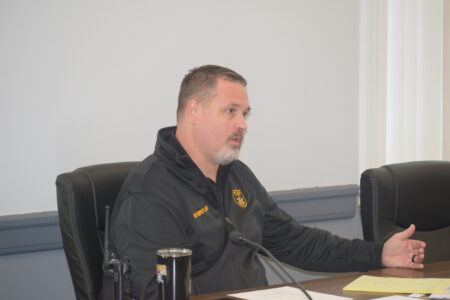Ohio County Commissioners Approve Opioid Funding for License Plate Readers

photo by: Derek Redd
Ohio County Chief Deputy Kent Lewis discusses the potential purchase of license place readers with opioid settlement money during Tuesday’s Ohio County Commission meeting.
The Ohio County Commission voted unanimously Tuesday morning to purchase license plate readers for the Ohio County Sheriff’s Office, which will be installed around the county.
Commissioners approved the new system, which will cost $57,900 for installation and the first three years of the service, and $18,000 annually thereafter. The initial installation and first three years will be funded through opioid settlement funds the county received through the West Virginia First Foundation.
Ohio County Sheriff Nelson Croft first requested the new readers during the commission’s first meeting of September. Croft said in that meeting that the Sheriff’s Office would apply for funding for the readers from the West Virginia First Foundation itself, but county officials learned Monday that, with the next round of funding, grant requests would fall into one of five categories, none of which fit the readers. The county commission has more discretion on how to distribute the funds that were given directly to it.
With Sheriff Nelson Croft out of town for a conference, Chief Deputy Kent Lewis appeared before commissioners Tuesday to discuss the purchase.
The plan, Lewis said, would be to put two readers at The Highlands, one at Dixon’s Run Road on U.S. 40 entering Ohio County, one on Interstate 470 entering the county from Ohio and one on Interstate 70 near the Wheeling Tunnel.
“This will be another tool in our arsenal to be able to help combat these areas that we obviously have a problem with,” Lewis said.
Lewis said the plate readers would help in opioid control because the illegal drugs enter Ohio County across both the Ohio and Pennsylvania borders. Those readers should help track interstate travel through that high-traffic area.
“Entering a license plate after we’ve done a controlled buy or identified a target vehicle, then we know when it’s entered the county,” he said. “Then we can move resources to address that situation before it can be distributed into the community and we have to deal with the opioids and all the crime that comes with that.”
Lewis added that it would help with other crimes, such as hit-and-runs and shoplifting. The cameras also connect with other counties using the technology, so if the Ohio County Sheriff’s Office puts a plate into the system, the other counties in the system also are alerted.
Installation could be less expensive, Lewis said, if the camera company can find existing structures on which to attach the readers. They can also be moved to different areas as needed, though that would incur an additional fee.



